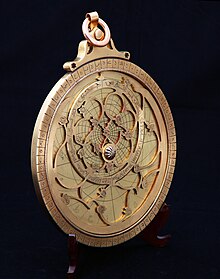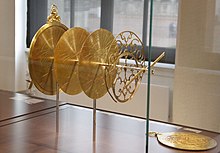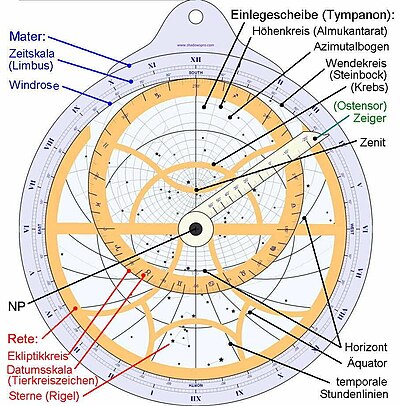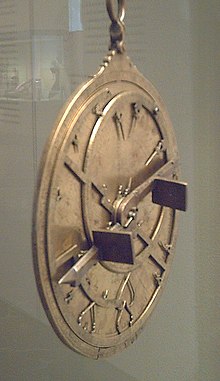Astrolabe

An astrolabe (also astrolabe , Greek for "star-taker") or planispherum is a disc-shaped astronomical instrument. It can be used to simulate the rotating sky .
The horizon and circles of the horizontal coordinate system are shown on a solid disc ( tympanum ) . Above is the rotatable rete , which contains a few stars as a celestial body and the annual orbit of the sun ( ecliptic ). Some of the many possible uses are as follows: If the Rete is set to date and time , the positions of the stars can be read. Conversely, the time or the cardinal points can be determined from the date and the position of a star or the sun .
Mostly there is a diopter on the back , with which the elevation angle of an object on earth or in the sky (for example star or sun) can be measured above the horizon. The traditional Greek meaning as "star taker" or "star altimeter" comes from this additional device, which was also used in seafaring to determine the latitude before the sextant .
Astrolabes were used from ancient times to the early modern period . The two-dimensional star maps still in use today are simplified modifications of the astrolabe. In the representation of the rotating sky, the more vivid, three-dimensional representational planetarium has replaced the astrolabe.
Representation principle
The astrolabe is viewed as an armillary sphere transferred into the plane , which has the consequence that it is now also called spherical astrolabe and the astrolabe is called plane armillary sphere . The transmission takes place with the help of stereographic projection . Their projection center is a point on the armillary sphere or on the celestial sphere to be depicted. The southern or northern celestial pole around which the sky (apparently) rotates are preferred . Since the astrolabe was intended exclusively for the representation of the northern sky at the time of its invention , the classical specimens contain the projection from the south pole. The north pole is the center and pivot point on the astrolabe.
In ancient times it was a tradition to prefer the view of the celestial sphere from the outside. An armillary sphere is also seen. The view from the outside was artificially created in the astrolabe by mirroring the inner view of the celestial sphere obtained through the stereographic projection. This is primarily recognizable by the mutual arrangement of the star symbols on the rete and by their direction of rotation. The constellations seen from Earth and those depicted on the Rete are mirror images of each other. The Rete rotates clockwise ; from earth, however, the sky is observed rotating counterclockwise around the north pole.
history
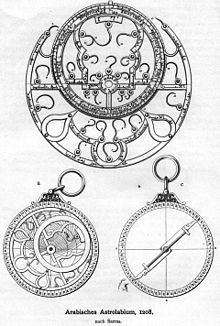
Above: Rete (openwork disc with an eccentric zodiac and stars as the tips of thorns).
Bottom left: front with rete .
Bottom right: back ( dorsum ) with alidade
The armillary sphere is said to have been discovered by the Greek astronomer Eratosthenes around 250 BC. Developed. The Greek astronomer Hipparchus (approx. 190–120 BC) added a sighting device to the innermost “astrolab ring” for aiming at a star. The oldest complete description is in the Arabic-mediated astronomy work Almagest by Ptolemy (approx. 100–160 AD). This was used to create the star catalogs of Hipparchus and Ptolemy.
The flat, disc-shaped astrolabes, which have been well known since the Middle Ages , were developed in the Greco-Roman area, although the exact point in time between the second and fourth centuries is uncertain. The astrolabe combines mathematical knowledge from the time of Hipparchus with elements from earlier mechanical instruments such as the dioptra (a universal geodetic instrument) and portable sundials based on stereographic projection from the second century. According to the Byzantine lexicon Suda (970 AD), the oldest known writing on the astrolabe was written by the astronomer Theon of Alexandria (approx. 330–400 AD), father of the mathematician Hypatia , in the late fourth century. The astrolabes were further developed in the Arab world, and a woman is said to have played a role, Ijlîya, the daughter of al-Ijlî al-Asturlâbi, an astrolab maker from Aleppo.
The astrolabe as an instrument for the representation of the celestial movements, for the localization of stars, for angle and time measurement, provided with a zodiac for astrological speculation developed from the Roman natural sciences, based on ancient sources. Such existed mainly in the scholarly city and in the library of Alexandria . Important stations of the astrolabe up to the European High Middle Ages are:
Stations
• Synesius of Cyrene, after his training in Alexandria, brought in 399 as envoy a planispherium (astrolabe) as a gift to the Eastern Roman imperial court in Byzantium ( Synesios of Cyrene / About the gift ), including description (not received).
• Also in Alexandria around 530 the Christian scientist Johannes Philoponos described the instructions for use of an "astrolábos" (star claw). It is the oldest surviving description of the astrolabe.
• From the 8th century onwards, Arabic scholars used the astrolabe as a device for astronomical and astrological calculations, along with the Indian decimals ( Arabic numerals ). The written instructions that the mathematician and astronomer al-Chwarizmi wrote in Baghdad around 840 are well known.
• In Arab Spain, at the court of the caliphs in Córdoba ( Caliphate of Córdoba / heyday ) after 930, culture and science flourished in an almost always peaceful coexistence of Muslims, Jews and Christians. A lively activity of translating ancient texts from the natural sciences and medicine into Arabic and from Arabic into Latin developed here, in which Jews were also involved. From here, Latin translations were brought across the Pyrenees to the Frankish Empire.
• Such came to Fleury (Abbey) of Saint-Benoît-sur-Loire, where scholars and copyists worked. From 988 to 1004 Abbot Abbo von Fleury worked as a clergyman, as a music theorist and also as an astronomer. The Fleury library contained an important collection of ancient and medieval texts also outside of theology.
• One of the oldest descriptions of the astrolabe in Latin is Codex 196 of the Bern Burger Library . The parchment manuscript was probably made in Fleury in the 11th century. It gives instructions for using the astrolabe and contains five sketches and a table.
• It was from Fleury that the first knowledge of the astrolabe came to the centers of science in the German Empire. In the Reichenau Monastery on the island, the learned monk Hermann von Reichenau , who lived from 1013 to 1054, owned an astrolabe textbook in Latin: This has not been passed down to us as a whole, but it has been preserved as bookbinder waste in the Konstanz city archive. The text version indicates origin from Barcelona around 980. Hermann's abbot at Reichenau, Berno von Reichenau , had studied in Fleury and perhaps brought the book with him from there, an early Latin textbook on astrolabology.
• The same text version also includes the manuscript that belonged to the St. Emmeram Monastery (Regensburg) in the 12th century and is now kept in Munich ( Bayerische Staatsbibliothek , codex latinus 14689). It is an example of how such texts were passed on from Reichenau to other centers of the empire.
Hermann der Lahme created a blueprint for an astrolabe and used Arabic sources (construction instructions "De mensura astrolabii").
A uniformly rotating flat astrolabe extended to a clock can, however, already be recognized in the "elevator clock" (or "water clock") described by the Roman engineer Vitruvius (1st century BC). About a thousand years later, the "geared astrolabe" of the Persian astronomer Al-Biruni (973-1048) appears. In addition to the movement of the sun, this also represented that of the moon. Clockwork astrolabes ("astrolabe clocks ") have been erected since the end of the 14th century as mostly large public astronomical clocks , some of which still exist today.
In European shipping between the 15th and 17th centuries, very simple astrolabes were used as so-called sea astrolabes , which are the forerunners of the sextant . From the early 16th century was for angle measurement and the Jacob's staff used.
The astrolabe is less graphic than its predecessor, the three-dimensional armillary sphere , which was still used in Europe as a demonstration instrument by astronomers and teachers in the 14th to 17th centuries. But it is easier to use as a measuring device.
The name astrolabe has also been used since around 1930 for some astrogeodesy instruments , with which star passages are measured precisely at a constant elevation angle of mostly 60 °. This angle is defined on the one hand by a specially cut glass prism, on the other hand by a reflective mercury horizon or a leveling device . Well-known types are the Danjon astrolab, the circumzenital and the Ni2 prism astrolab from Zeiss . Depending on the complexity and weight, they allow the direction of the perpendicular to be determined with an accuracy of ± 0.01 "to 0.5".
Components and scales
Above the tympanum is the rotating, net-like openwork star disc ( rete ), the small tips of which serve as symbols ( star pointers ) for about two dozen selected bright stars in the sky. On the tympanum are the images of the horizon and a network of horizon coordinates . Since these images depend on the geographical latitude of the place of observation, they are displayed on interchangeable tympanums , one of which is inserted into the base plate ( mater ) of the astrolabe. This allows the astrolabe to be used in several latitude regions.
The base plate has a scale of the 24 hours of a day on its outer edge ( limbus , sometimes twice 12 hours or a 360 ° scale).
The horizontal celestial coordinates between horizon and zenith are shown on a tympanum : horizon, circles of height ( almucantarate ) and azimuth arcs . The images are circles, because circles are always shown as circles in stereographic projection. In addition, there are the celestial equator circles centered on the celestial pole and the two celestial tropics . The arcs below the horizon are lines of temporal hours .
On the Rete , single stars ( star pointers ) and the ecliptic are shown as a date circle marked with the zodiac or directly with the calendar date. Seen from the earth, the sun changes its position relative to the fixed star sky in the course of the year, it passes through the ecliptic circle.
A rotatable pointer ( Ostensor ) helps to set the date on the ecliptic by turning it to match the time on the hour scale ( limbus ) on the edge of the mater . In some variants, the pointer has a declination scale .
On the back ( dorsum ) there is a rotating double pointer ( alidade ) with a diopter, with which the elevation angle of a star can be measured. One of several scales is used for this, the astrolabe must hang exactly vertically on the retaining ring ( armilla ).
Use of the astrolabe
The astrolabe has been a universal instrument for astronomers, surveyors and astrologers for many centuries. It also served as a timer and to determine calendar dates. But often it was just a beautiful piece of jewelry owned by wealthy laypeople. What hindered the spread of the astrolabe, however, was the good knowledge of astronomy and mathematics that one had to have in order to use it. While the instrument for altitude measurement could still be used in any setting with little knowledge, it was necessary to carry out a complicated basic setting before an astronomical measurement.
What is described in the following paragraphs about the bearing of the stars shown in the night sky also applies to the sun during the day.
Applications included: measuring the height of the stars or the sun, determining the equinox, determining the temporal hours, determining the times of rising and setting, observing twilight, geodetic measurements and astrological predictions.
Of the many possible uses of an astrolabe, only a selection is discussed below.
Set current sky and identify stars
- The east sensor is set to the current date on the ecliptic. That is the place of the sun. If it is within the horizon circle (above the horizon), it is day.
- Rete and Ostensor are rotated together until the Ostensor points to the current solar time on the hour ring. The star pointers of those stars that can be seen in the sky at this time are now within the horizon circle. Their positions can be read from the coordinate lines engraved in the mater (or tympanum).
Determine local time
- A well-known star is aimed at using the rotating alidade on the back of the vertically hanging astrolabe. The alidade then shows the current elevation angle of the star on the degree scale.
- It is determined whether the star is currently in the eastern or western half of the sky, that is, whether it is currently ascending or descending.
- The rete is rotated until the pointer of the known star is above the circle engraved in the mater (almukantarate) that indicates the height measured in the first step. In general there are two options, one in the eastern half and one in the western half. The right one was determined in the second step.
- The east sensor is set to the current date above the ecliptic. Then it shows the true local time on the hour circle of the mater (limbus) .
Determine cardinal points
- The azimuth arc, over which a star pointer was brought in one of the applications described above, indicates the compass direction in which the star is, more precisely: the direction in which its azimuth arc ( vertical circle ) intersects the horizon. With some astrolabes, the horizon circle is scaled with the azimuth angles.
Astronomical clocks
An astrolabe can also be used to reproduce the (apparent) even rotation of the sky if the rete is rotated evenly and at the appropriate speed. The combination of an astrolabe with a clockwork is the so-called astrolabe clock, the most vivid variant of the astronomical art clocks .
Astrolabes used in the northern hemisphere contain the so-called northern projection: projection from the southern celestial pole, northern pole star in the center of rotation. Since the sun, as a "time maker", is mainly above the southern horizon, its movement is shown more clearly in the so-called southern projection and is therefore preferably used in astrolabe clocks. The horizon is convex in shape, the sky shown rotates in the usual clockwise direction , which means that it could have originated from the astrolabe clocks.
The astrolabe is primarily about the representation of the stars, with a clock it is about the display of the 24 hours. The latter is indicated by the sun added to the astrolabe. The sun symbol rotates together with the hour hand, so it lags behind the stars by around 4 minutes (1 °) per day. The drive of the Rete , which mostly only contains the stars or signs of the zodiac combined in the ecliptic ring, is designed so that it rotates around 1 ° more than once in 24 hours. The sun symbol is also guided on the ecliptic circle, on which it lags about 1 ° daily and in this way represents the backward movement of the sun through the zodiac once a year. As a result of the eccentricity of the ecliptic circle, the symbol sun has different distances from the center of rotation over the year, which in turn corresponds to the change in the seasonal sun height .
Usually the movement of the moon is also shown in them. The more elaborate representation of the planetary movements has rarely been attempted.
Comparison with star maps
Rotatable star maps can be understood as modified astrolabes. Their rete has also become the rotating star disc. This contains significantly more stars according to the limited purpose of making it easier for laypeople to orientate themselves in the starry sky through comparative observation. For this, several scales are dispensed with, so that many quantitative measurement, determination and conversion functions are no longer possible. The rotation of the star disk simulates the rotation of the starry sky. The possibility of setting them relative to the horizon helps to hide the part of the sky that is not visible at the time of observation on the star map. In contrast to the astrolabe, the azimuthal equidistant projection is often used instead of the stereographic one . The main difference is that the astrolabe's usual view from the outside has been given up in favor of the view from the earth against the starry sky. Therefore, the constellations on the star maps are not mirror-inverted, but must be held upside down for comparison with the night sky.
Trivia
In the US series Warehouse 13, there is a magical, mysterious astrolabe that can be used to set the time back.
See also
- Torquetum , a further development of the armillary sphere.
- Planisphere , a rotatable star map without a measuring function.
- Dioptra , antique geodetic instrument with a comparable sighting device.
literature
- Werner Bergmann: Innovations in the Quadrivium of the 10th and 11th Centuries. Studies on the introduction of the astrolabe and abacus in the Latin Middle Ages (= Sudhoffs archive. Supplement 26). Steiner, Stuttgart 1985, ISBN 3-515-04148-6 ( Habilitation University Bochum 1985).
- Arianna Borrelli: Aspects of the Astrolabe. “Architectonica ratio” in tenth- and eleventh-century Europe (= Sudhoffs Archive. Supplement 57; History of Science ). Steiner, Stuttgart 2008, ISBN 978-3-515-09129-9 ( dissertation at the Technical University of Braunschweig , 2006, English).
- Arno Borst: Astrolabe and monastery reform at the turn of the millennium. (= Meeting reports of the Heidelberg Academy of Sciences, philosophical-historical class. Year 1989, No. 1). Heidelberg 1989 ,; ISBN 3-533-04146-8 .
- Martin Brunold: The brass sky. A guide to the astrolabe. Institut l'Homme et le Temps, La Chaux-de-Fonds 2001, ISBN 2-940088-11-X .
- Martin Brunold: The astrolabe. In: Cartographica Helvetica. 23, 2001, ISSN 1015-8480 , pp. 19-25.
- Raymond d'Hollander: L'astrolabe: Histoire, théorie et pratique . Institut océanographique, Paris 1999, ISBN 2-903581-19-3 . (French).
- Gottfried Gerstbach : Contributions to the optimization of astrolabe observations. In: Geoscientific Communications. 7, 1976, ISSN 1811-8380 , pp. 103-134.
- Johann Hügin: The astrolabe and the clock. Kempter, Ulm 1978, ISBN 3-921348-23-4 . (a German-language introduction to the astrolabe)
- Edward S. Kennedy, P. Kunitzsch, R. Lorch (Eds.): The Melon-shaped Astrolabe in Arabic Astronomy. (= Boethius . Volume 43). Steiner, Stuttgart 1999, ISBN 3-515-07561-5 (English, Arabic).
- David A. King: Astrolabes from Medieval Europe. (= Variorum Collected Studies Series . Volume 977). Ashgate, Farnham 2011, ISBN 978-1-4094-2593-9 (English).
- Ludwig Meier: Heaven on earth. The world of planetariums. Ambrosius Barth, Leipzig / Heidelberg 1992, ISBN 3-335-00279-2 .
- Henri Michel: Traité de l'astrolabe. Gauthier-Villars, Paris 1947. (Réimpression en fac-similé: Brieux, Paris 1976)
- Henri Michel, Paul Adolf Kirchvogel (editor and translator): Measuring over time and space: measuring instruments from 5 centuries. Belser, Stuttgart 1965 (original title: Instruments des sciences dans l'art et l'histoire ), DNB 453370926 .
- James E. Morrison: The Astrolabe. Janus, Rehoboth Beach, Delaware 2007, ISBN 978-0-939320-30-1 .
- National Maritime Museum, Greenwich: The Planispheric Astrolabe. National Maritime Museum - Department of Navigation and Astronomy, Greenwich 1976.
- Günther Oestmann : History, construction and application of the astrolabe in dials of astronomical clocks. Published by Musée International D'Horlogerie La Chaux-de-Fonds. Athena, Oberhausen / Edition Institut l'Homme et le Temps, La Chaux-de-Fonds 2014, ISBN 978-3-89896-572-9 .
- Ioannes Philoponus: De usu astrolabii eiusque constructione / About the use of the astrolab and its manufacture. edited by Alfred Stückelberger. de Gruyter, Berlin 2015, ISBN 978-3-11-040277-3 .
- Burkhard Stautz: The astrolabe collections of the German Museum and the Bavarian National Museum. (= Deutsches Museum - Treatises and Reports. NF. Volume 12). Oldenbourg, Munich 1999, ISBN 3-486-26479-6 .
- Burkhard Stautz: Investigations of mathematical-astronomical representations on medieval astrolabes of Islamic and European origin. Publishing house for the history of natural sciences and technology, Bassum 1997, ISBN 3-928186-29-9 (dissertation University of Frankfurt am Main 1995).
- Joachim Wiesenbach: Wilhelm von Hirsau, astrolabe and astronomy in the 11th century ; in: Klaus Schreiner (arrangement): Hirsau. St. Peter and Paul . 2 parts (= research and reports of archeology in Baden-Württemberg. Vol. 10), Stuttgart 1991; ISBN 3-8062-0902-2 , Volume 2, pp. 109–156, ill.
Web links
- Website about an exhibition at the University of Erlangen with many references , accessed January 5, 2015
- Erasmus Habermel's astrolabe , Deutsches Museum, Munich, accessed January 5, 2015
- Martin Brunold: The astrolabe . In: Cartographica Helvetica , Fachzeitschrift für Kartengeschichte, Volume 23–24 (2001), Issue 23, pp. 19–25 (digitized version: ETH Zurich ), accessed January 5, 2015
- Siegfried Wetzel: Astrolabe, clock and clock-pointer sense , accessed January 5, 2015
- James E. Morrison, Janus: astrolabes.org , accessed January 5, 2015
Individual evidence
- ^ Germanisches Nationalmuseum : Online object catalog Astrolabe des al-Sahl al-Nisaburi
- ↑ Ludwig Meier: Heaven on earth . Ambrosius Barth, 1992, p. 14, illustration on p. 13
- ↑ Theon's writing has not survived, but a detailed table of contents can be found in a writing by al-Yaqubi written around 880 , cf. Otto Neugebauer, A History of Ancient Mathematical Astronomy, Berlin 1975, 877-878
- ↑ Johannes Philoponos: De usu astroloabii eiusque constructione. Edited with the assistance of Heinrich Rohrer, translated and explained by Alfred Stückelberger. De Gruyter, Berlin 2015 (= Bibliotheca scriptorum Graecorum et Romanorum Teubneriana. 2016), ISBN 978-3-11-040221-6 ; Greek and German text in parallel.
- ^ Arno Borst: Astrolabe and monastery reform at the turn of the millennium. Heidelberg 1989 (= meeting reports of the Heidelberg Academy of Sciences, philosophical-historical class. Year 1989, No. 1); ISBN 3-533-04146-8 , especially pp. 18-20.
- ↑ Ernst Zinner: About the earliest form of the astrolab ; in: Report of the Naturforschenden Gesellschaft Bamberg , 30, 1947, pp. 9-21, esp. pp. 15-17.
- ^ Marco Mostert: The library of Fleury, a provisional list of manuscripts ; ed. Lost, Hilversum 1989; 315 p .; (Middeleeuwse studies en bronnen , 3); ISBN 90-6550-210-6 .
- ^ The astrolab text from the manuscript Codex 196, Burgerbibliothek Bern, Traces of Arabic Science in the Medieval Occident , by Matthias Schramm, Carl-Philipp Albert and Michael Schütz, Martin Brunold; in: Journal for the History of Arab-Islamic Sciences : ZGAW = Mag allat ta ri h al-ulu m al-arabi ya wa'l-islamiya / Institute for the History of Arab-Islamic Sciences at the Johann Wolfgang Goethe University in Frankfurt a. M. Volume 17, 2006/2007, pp. 199-300, edition of the Latin text with German translation; therein by Martin Germann: History of the handwriting and its tradition , pp. 200–202.
- ^ Arno Borst: Astrolabe and monastery reform at the turn of the millennium ; Heidelberg 1989; 141 p., Ill. ( Meeting reports of the Heidelberg Academy of Sciences, Philosophical-Historical Class , year 1989 No. 1), ISBN 3-533-04146-8 ; esp. pp. 46-59.
- ^ Arno Borst: Astrolabe and monastery reform at the turn of the millennium ; Heidelberg 1989; 141 p., Ill. ( Meeting reports of the Heidelberg Academy of Sciences, Philosophical-Historical Class , year 1989 No. 1), ISBN 3-533-04146-8 ; esp. pp. 118-119.
- ↑ Helmut Minow: Hermann Contractus: Astrolabe and Earth measurement . ( Memento from February 16, 2015 in the Internet Archive ) (PDF) In: Geomatik Schweiz , 1/2008
- ^ Hermann Contractus: Liber de mensura astrolabii
- ↑ Gustav Bilfinger: The timepieces of the ancient peoples . 1886
- ↑ Ludwig Meier: Heaven on earth . Ambrosius Barth, 1992, p. 15 and 16
- ↑ Ludwig Meier: Heaven on earth . Ambrosius Barth, 1992, p. 14.
- ^ Samuel Guye, Henri Michel: Clocks and measuring instruments of the 15th to 19th centuries . Orell Füssli, 1971.
- ↑ Ralf Kern: Scientific instruments in their time . Volume 1: From astrolabe to mathematical cutlery . Cologne 2010, p. 209 a. 210.
- ↑ Ralf Kern: Scientific instruments in their time . Volume 1: From astrolabe to mathematical cutlery . Cologne 2010, pp. 211-213.
- ↑ It could also have been adopted from the astrolabes. These traditionally contain the northern projection, which is also mirrored, because in ancient times it was preferred to make a picture of the sky seen from the outside. Thus in them the sky (the Rete ) also rotates in the usual clockwise direction. See also swetzel.ch: Astrolabe, Uhr und Uhrzeiger -Sinn , accessed on February 22, 2011.
